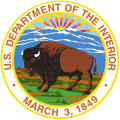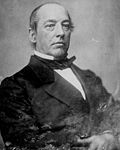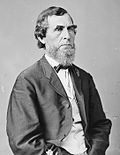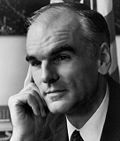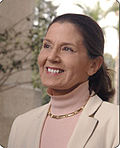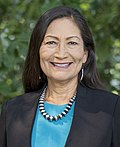Parties Whig Democratic Republican
Status Denotes
acting Secretary of the Interior
Number Portrait Name State of residence Took office Left office President(s) 1 Thomas Ewing Ohio March 8, 1849 July 22, 1850 Zachary Taylor Millard Fillmore 2 Thomas McKennan Pennsylvania August 15, 1850 August 26, 1850 3 Alexander Stuart Virginia September 14, 1850 March 7, 1853 4 Robert McClelland Michigan March 8, 1853 March 9, 1857 Franklin Pierce 5 Jacob Thompson Mississippi March 10, 1857 January 8, 1861 James Buchanan 6 Caleb Smith Indiana March 5, 1861 December 31, 1862 Abraham Lincoln 7 John Usher Indiana January 1, 1863 May 15, 1865 Andrew Johnson 8 James Harlan Iowa May 16, 1865 August 31, 1866 9 Orville Browning Illinois September 1, 1866 March 4, 1869 10 Jacob Cox Ohio March 5, 1869 October 31, 1870 Ulysses S. Grant 11 Columbus Delano Ohio November 1, 1870 September 30, 1875 12 Zachariah Chandler Michigan October 19, 1875 March 11, 1877 13 Carl Schurz Missouri March 12, 1877 March 7, 1881 Rutherford B. Hayes 14 Samuel J. Kirkwood Iowa March 8, 1881 April 17, 1882 James A. Garfield Chester A. Arthur 15 Henry M. Teller Colorado April 18, 1882 March 3, 1885 16 Lucius Lamar Mississippi March 6, 1885 January 10, 1888 Grover Cleveland 17 William Vilas Wisconsin January 16, 1888 March 6, 1889 18 John Noble Missouri March 7, 1889 March 6, 1893 Benjamin Harrison 19 Hoke Smith Georgia March 6, 1893 September 1, 1896 Grover Cleveland 20 David R. Francis Missouri September 3, 1896 March 5, 1897 21 Cornelius Bliss New York March 6, 1897 February 19, 1899 William McKinley 22 Ethan Hitchcock Missouri February 20, 1899 March 4, 1907 Theodore Roosevelt 23 James Garfield Ohio March 5, 1907 March 4, 1909 24 Richard A. Ballinger Washington March 6, 1909 March 12, 1911 William Howard Taft 25 Walter L. Fisher Illinois March 13, 1911 March 5, 1913 26 Franklin Lane California March 6, 1913 February 29, 1920 Woodrow Wilson – Alexander T. Vogelsang Acting California February 29, 1920 March 13, 1920 27 John Payne Illinois March 15, 1920 March 4, 1921 28 Albert B. Fall New Mexico March 5, 1921 March 4, 1923 Warren G. Harding 29 Hubert Work Colorado March 5, 1923 July 24, 1928 Calvin Coolidge 30 Roy West Illinois July 25, 1928 March 4, 1929 31 Ray Lyman Wilbur California March 5, 1929 March 4, 1933 Herbert Hoover 32 Harold L. Ickes Illinois March 4, 1933 February 15, 1946 Franklin D. Roosevelt Harry S. Truman – Oscar L. Chapman Acting Colorado February 15, 1946 March 18, 1946 33 Julius Krug Wisconsin March 18, 1946 December 1, 1949 34 Oscar L. Chapman Colorado December 1, 1949 January 20, 1953 35 Douglas McKay Oregon January 21, 1953 April 15, 1956 Dwight D. Eisenhower – Clarence Davis Acting Nebraska April 15, 1956 June 8, 1956 36 Fred Seaton Nebraska June 8, 1956 January 20, 1961 37 Stewart Udall Arizona January 21, 1961 January 20, 1969 John F. Kennedy Lyndon B. Johnson 38 Wally Hickel Alaska January 24, 1969 November 25, 1970 Richard Nixon – Fred J. Russell Acting California November 25, 1970 January 29, 1971 39 Rogers Morton Maryland January 29, 1971 April 30, 1975 Gerald Ford – Kent Frizzell Acting Kansas April 30, 1975 June 12, 1975 40 Stanley K. Hathaway Wyoming June 12, 1975 October 9, 1975 – Kent Frizzell Acting Kansas October 9, 1975 October 17, 1975 41 Thomas S. Kleppe North Dakota October 17, 1975 January 20, 1977 – Alfred Albert Acting January 20, 1977 January 23, 1977 Jimmy Carter 42 Cecil D. Andrus Idaho January 23, 1977 January 20, 1981 43 James G. Watt Colorado January 23, 1981 November 8, 1983 Ronald Reagan – J. J. Simmons Acting New Jersey November 8, 1983 November 18, 1983 44 William P. Clark California November 18, 1983 February 7, 1985 45 Donald P. Hodel Oregon February 8, 1985 January 20, 1989 – Earl Gjelde Acting Virginia January 20, 1989 February 3, 1989 George H. W. Bush 46 Manuel Lujan Jr. New Mexico February 3, 1989 January 20, 1993 47 Bruce Babbitt Arizona January 22, 1993 January 19, 2001 Bill Clinton – Thomas Slonaker Acting Arizona January 20, 2001 January 31, 2001 George W. Bush 48 Gale Norton Colorado January 31, 2001 March 31, 2006 – Lynn Scarlett Acting California April 1, 2006 May 26, 2006 49 Dirk Kempthorne Idaho May 26, 2006 January 19, 2009 – Lynn Scarlett Acting California January 19, 2009 January 20, 2009 Barack Obama 50 Ken Salazar Colorado January 20, 2009 April 12, 2013 51 Sally Jewell Washington April 12, 2013 [ 6] January 20, 2017 – Kevin Haugrud Acting January 20, 2017 March 1, 2017 Donald Trump 52 Ryan Zinke Montana March 1, 2017 January 2, 2019 53 David Bernhardt Colorado January 2, 2019 April 11, 2019 April 11, 2019 January 20, 2021 – Scott de la Vega Acting New York January 20, 2021 March 16, 2021 Joe Biden 54 Deb Haaland New Mexico March 16, 2021 January 20, 2025 – Walter Cruickshank Acting January 20, 2025 February 1, 2025 Donald Trump 55 Doug Burgum North Dakota February 1, 2025 present
